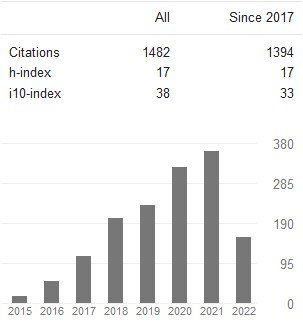Wound healing; antimicrobial and anti-oxidant activity for Jordanian Juglans Regia L. unripe fruits
Abstract
The present study, attempts to evaluate, extraction efficiency of unripe fruit of J. regia in Jordan using different solvents with soxhlet and microwave extraction methods. We used five different types of solvents according to their increase in polarity to cover a wide range of phytochemical products. We examined the presence of some secondary metabolites as Tannins, Flavonoids, Saponins, and Alkaloids, as well as total phenols. Our results showed a higher efficiency for the microwave extraction method over the soxhlet extraction method in terms of higher yield amount and less time and solvents consuming. Water usage as an extraction solvent has generated the highest yield amount of 1.3 g in the defatted J. regia using microwave methods, whereas, the highest concentration of total phenols was demonstrated in the ethyl acetate extract of J. regia. In the antimicrobial susceptibility test, the ethyl acetate extract of J. regia showed a significant MIC inhibition concentration of 0.85 mg/ml against S. aureus, P. aerogenosa, and S. epidermidis. The healing activity of the ethyl acetate extract was as good as the reference drug (Baneocin) and even the ethyl acetate had an increase of 5% (P˂ 0.05) than reference drug
Keywords:
Juglans regia L, Unripe fruit, Wound healing, Microwave extraction, AntioxidantDownloads
Published
How to Cite
Issue
Section
Copyright (c) 2018 Afaf H. Al-Nadaf, Nesrin J. Seder, Walid Abu Rayyan

This work is licensed under a Creative Commons Attribution-NonCommercial-ShareAlike 4.0 International License.



 Journal of Innovations in Pharmaceutical and Biological Sciences is licensed under a Creative Commons Attribution-NonCommercial-ShareAlike 4.0 International License. Based on a work at
Journal of Innovations in Pharmaceutical and Biological Sciences is licensed under a Creative Commons Attribution-NonCommercial-ShareAlike 4.0 International License. Based on a work at